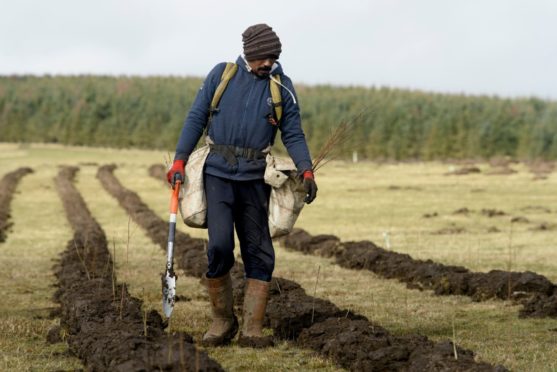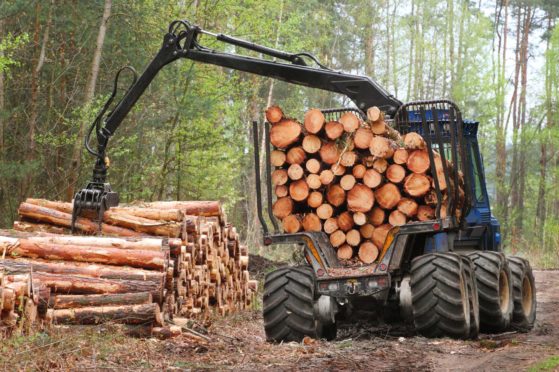Scotland’s forestry and wood processing industry is a modern-day success story, especially north of the central belt.
80% of all the UK’s new woodland is being planted in Scotland and that is driving huge investment by wood processors. Norbord has ploughed more than £100 million into its Dalcross mill near Inverness – one of the biggest investments Scotland has seen for many years.
Scotland is the only part of the UK to have set specific targets for wood use in construction, and the growth of the industry here is creating great career opportunities for young people looking to work in the green economy.
In our manifesto for the 2021 Scottish Parliament elections, Building a Greener Future: A Forestry and Timber Manifesto for Scotland, Confor – which represents 1,500 forestry and wood-using businesses – has set out how Scotland can build on that success, delivering for the economy and the environment at the same time.
Sawmillers like BSW, James Jones & Sons, Cordiners, Munros at Dingwall and John Gordon and Sons in Nairn are major local employers whose businesses are also locking up carbon and displacing more carbon-heavy concrete, steel and brick – especially important in the year that global climate summit COP26 comes to Glasgow.
Scotland wants to hit net-zero by 2045 – five years ahead of the rest of the UK. Net-zero means balancing the amount of greenhouse gas produced with the amount removed from the atmosphere.
To achieve that we need to plant more trees and use more wood, another area where Scotland is leading – currently 85% of new homes use timber frame compared to around just 25% in England.
The forestry and wood processing industry supports more than 25,000 jobs across Scotland, most of which are in rural areas with few other main sources of employment.
Large, forested areas like Glen Tanar, Moray and Seafield to the great forests of Argyll support a wide range of jobs and there is scope for more which is great news for forest management companies including Scottish Woodlands, Tilhill and Cawdor Forestry.
The social benefits of forests and woods have been clear for all to see in the last year, with people appreciating local woodlands more than ever as places for walking, cycling and bird-watching – vital for physical and mental health during the pandemic.
Now, as we seek to build back better from Covid-19, forestry and wood can deliver those simultaneous economic, environmental and social benefits.
In our manifesto, discussed and supported by politicians from all the main parties at our election hustings last month, we explain how we can go further, with five simple calls to action.
The first is to hit tree planting targets.
The target of 18,000 hectares of new planting each year by 2024-5 is achievable – and as set out in Scotland’s Forestry Strategy, adopted with cross-party support by the Scottish Parliament in 2019, 60% of trees planted should be productive species to provide wood, reduce carbon impacts, create long-term employment and support wildlife.
The second is to increase wood use in construction.
The Scottish Government has set a target to increase the amount of wood used in construction to 3 million cubic metres annually by 2031-2. Confor sees this as a minimum target, to be annually reviewed, and hopefully met by 2030.
The third is to invest in skills as 21st Century forestry and wood processing jobs are increasingly hi-tech and highly-skilled – very different from the stereotype.
With an ageing workforce, there are great opportunities for young people in the forests and mills across Scotland. Public bodies Scottish Forestry and Forestry & Land Scotland are doing excellent work, alongside industry and the Scottish School of Forestry at Inverness, but we need many more new people coming into our industry to support its growth.
The fourth call to action is to fund timber transport.
The Strategic Timber Transport Fund has been vital in creating forest roads, and improving local public roads and we need support maintained over the new parliamentary term to ensure timber is moved safely in our rural communities.
Confor also supports off-road solutions, and work continues to develop a new timber rail freight service at Rannoch Station, north of Pitlochry, which could see 500,000 tonnes of timber moved by train over the next decade – while the Red Princess transports large quantities of timber by sea from the forests of Argyll.
The last call for action is for the creation of a forest and timber innovation hub, which would work with Scotland’s innovation centres, to commercialise low-carbon, wood-based products to add value to the economic contribution of Scotland’s forests.
This would build on the kind of innovative work going on at sites like James Jones & Sons in Forres, which supplies high-quality engineered timber products to all the main UK housebuilders. Almost £15m has been invested in the site in the last six years.
The five points are a package, designed to continue building an industry which can deliver for our environment, economy and society – and ensure a genuinely greener future for Scotland.
- Stuart Goodall is chief executive of Confor: promoting forestry and wood. Confor’s election manifesto can be read here


